towing AUDI A8 2013 User Guide
[x] Cancel search | Manufacturer: AUDI, Model Year: 2013, Model line: A8, Model: AUDI A8 2013Pages: 318, PDF Size: 79.34 MB
Page 118 of 318
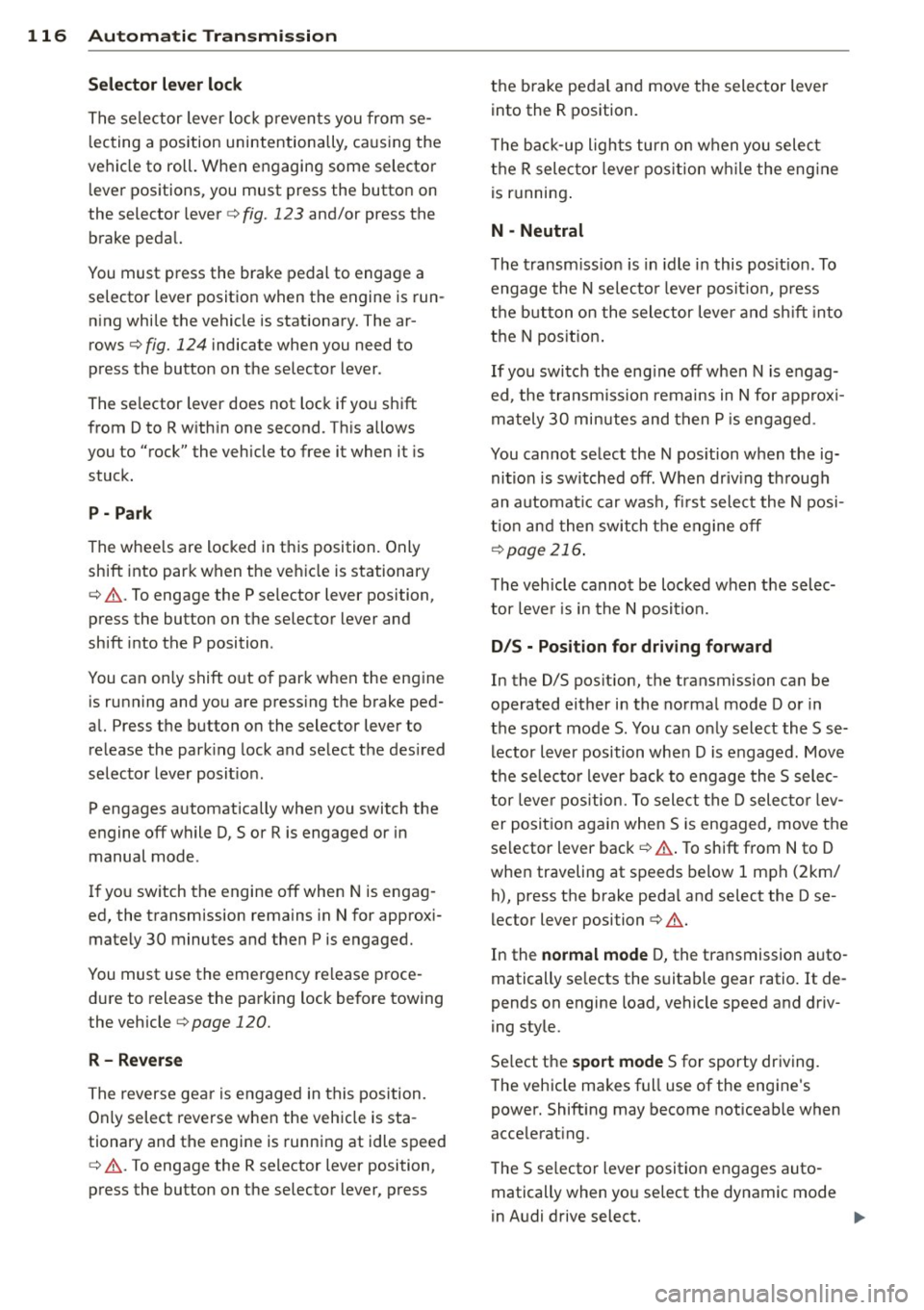
116 Automatic Transmission
Selector lever lock
The selector lever lock prevents you from se
l ecting a position unintentionally, causing the
vehicle to roll. When engaging some selector lever positions, you must press the button on
the selector lever<=>
fig. 123 and/or press the
brake pedal.
You must press the brake pedal to engage a
selector lever position when the engine is run
n ing while the vehicle is stationary. The ar
rows¢
fig. 124 indicate when you need to
press the button on the selector lever.
The selector lever does not lock if you shift
from D to R within one second . This allows
you to "rock" the vehicle to free it when it is
stuck.
P - Park
The whee ls are locked in this position. Only
shift into park when the vehicle is stationary
¢ & .To engage the P selector lever position,
press the button on the selector lever and
shift into the P position.
You can only shift out of park when the eng ine
is running and you are pressing the brake ped
al. Press the button on the selector lever to
release the park ing lock and select the des ired
selector lever posit ion.
P engages automatically when you switch the
engine off while D, Sor R is engaged or in
manual mode.
If you switch the engine off when N is engag
ed, the transmission remains in N for approxi
mately 30 minutes and then Pis engaged.
You must use the emergency release proce
dure to release the parking lock before towing
the vehicle
¢ page 120.
R - Reverse
The reverse gear is engaged in this position.
Only select reverse when the vehicle is sta
tionary and the engine is running at idle speed
¢ & .To engage the R se lector lever position,
press the button on the selector lever, press the
brake pedal and move the selector lever
into the R position.
T he back-up lights turn on when you select
the R selector lever position while the engine
is running .
N -Neutral
The transmission is in idle in this position. To
engage the N selector lever position , press
the button on the selector lever and shift int o
the N position.
If you switch the engine off when N is engag
ed, the transmission remains in N for approxi
mately 30 min utes and then Pis engaged.
You cannot select the N position when the ig
nition is switched off . When driving through
an automat ic car was h, first select the N posi
tion and then switch the engine off
¢page 216.
The vehicle cannot be locked when the selec
tor leve r is in the
N position.
D/S - Position for driving forward
In the D/S pos ition, the transmission can be
operated either in the normal mode Dor in
the sport mode S. You can only select the S se
lector lever position when Dis engaged. Move
the selecto r lever back to engage the S selec
tor lever position. To select the D selector lev
er position again when S is engaged, move the
selector lever back¢& . To shift from
N to D
when traveling at speeds below 1 mph (2km/
h), press the brake pedal and select the D se
lector lever position ¢
&.
In the normal mode D, the transmission auto
matically selects the suitable gear ratio.
It de
pends on engine load, vehicle speed and driv
ing style.
Select the
sport mode S for sporty driving.
T he vehicle makes full use of the engine's
power. Shift ing may become noticeab le when
acce lerat ing.
The S selector lever position engages auto
matically when yo u select the dynamic mode
in Audi drive select.
...
Page 119 of 318

& WARNING
-Never engage R or P wh ile driving. It
cou ld cause a crash .
-
-Power is sti ll transmitted to the whee ls
when the engine is running at idle. To prevent the vehicle from "creeping", you
must keep your foot on the brake in all
selector lever positions except P and N
when the engine is running. Do not inad
vertent ly press the accelerator pedal
when the veh icle is stationary . Otherwise
the vehicle will start to move immediate ly. This cou ld happen even if the parking
brake is activated.
- Before opening the hood, select the P se
lector lever position and set the par king
brake. This reduces the risk of a crash. A l
ways read and follow the applicable
warnings
¢page 226, Engine comport
ment.
- Never get out of the driver's seat when
the engine is running.
- If you must get out of the vehicle, move
the se lector lever securely into the P po
sit ion and apply the park ing brake .
@ Tips
-If you un intentionally shift into the N se
l ector lever position while dr iving, take
your foot off the accelerator pedal and
wait for the engine to slow down until it is idling before you shift into Dor S.
Driving tips
The gears shift outomoticolly .
Starting from a stop
"' Press and ho ld the brake pedal.
.,. Start the eng ine
q page 83.
"' Press the button on the se lector lever and
select the D, S or R selector lever position
¢ page 115.
"' Wait a moment until the transmission
shifts. You w ill not ice a slight movement
when the gear engages .
"' Re lease the brake pedal and press the accel
erato r peda l¢ _& .
Aut omat ic Tr ans missio n 11 7
Stopping temporarily
"' Press the b rake pedal to stop the veh icle,
for examp le at a traffic light . Do not press
the acce lerator pedal when doing this .
"' To prevent the vehicle from rolling when
you start driving, set the parking brake
when stopp ing on large inclines¢_& .
"' The parking brake will release automat ically
and the vehicle will start mov ing once you
press the acce lerator pedal.
Parking
If the selector lever is not in the P position
when you open the driver's door, the veh icle
could roll. The message
Transmission: Car
may roll! Shift to park !
appears.
"' Press and hold the brake pedal¢ _& .
"' Set the park ing brake.
"' To engage the P se lector lever position,
press the button on the selector lever and
shift into the P posit ion ¢
page 115 .
Under certa in conditions such as dr iv ing in the
mountains or when towing a trailer, it may be
helpful to switch to manual mode temporarily
to shift
manually to adapt to the dr iving con
ditions
¢ page 118.
On slopes, activate the parki ng brake first and
then move the selecto r leve r to the P position .
T his prevents too much st ress from be ing
placed on the locking mechanism.
& WARNING
Read and follow all WARNINGS ¢ .&. in Se
lecting o selector lever position on
page 117.
- The vehicle can also roll when the engine
is stopped.
- Do not press the accelerator pedal when
changing the selec tor lever position
while the vehicle is stationary and the engine is running . This could result in a
crash.
- Never engage R or P while driving . It
could cause a crash.
- Power is still transmitted to the wheels
when the engine is running at idle. To ..,.
Page 122 of 318
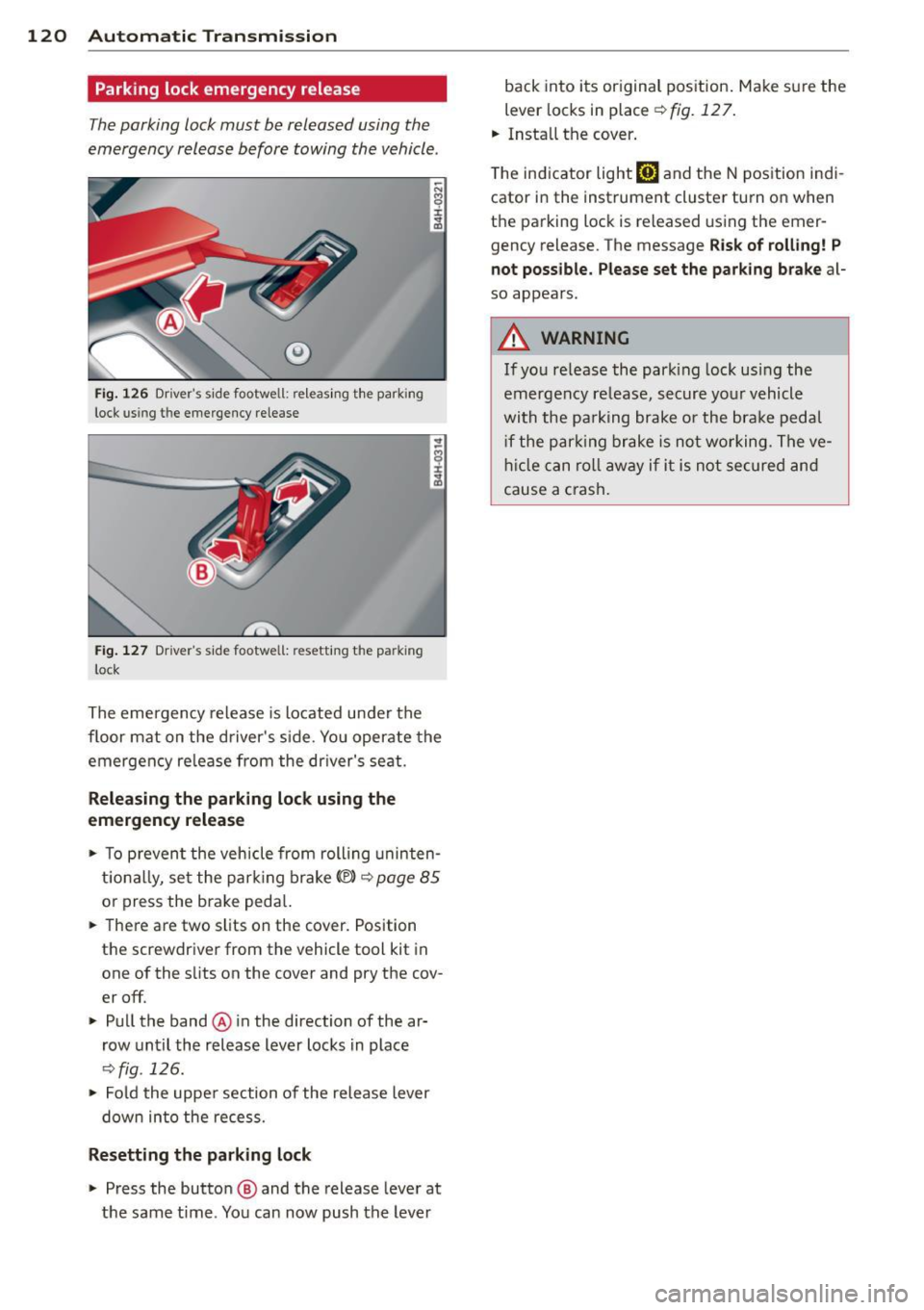
120 Automatic Transmission
Parking lock emergency release
The parking lock must be released using the
emergency release before towing the vehicle .
@
Fig. 126 Dr iver's side footwell: releasing t he park ing
lock us ing t he emergency release
Fig. 127 Drive r's s ide footwe ll: resetting th e pa rking
l ock
The emergency release is located under the
floor mat on the driver's side. You operate the
emergency re lease from the dr iver's seat.
Releasing the parking lock using the
emergency release
• To prevent the vehicle from rolling uninten
tionally, set the park ing brake© ¢
page 85
or press the brake peda l.
.. There are two slits on the cover. Position
the screwdriver from the vehicle tool kit in
one of the s lits on the cover and pry the cov
er off.
• Pull the band@ in the direction of the ar
row until the release lever locks in place
¢ fig . 126.
• Fold the uppe r section of the release lever
down into the recess.
Resetting the parking lock
• Press the button @ and the release lever at
the same time . You can now push the lever back into its original pos
ition . Make sure the
lever locks in place
¢fig. 127.
.. Install the cover .
T he indicator light
[O] and the N position indi
cator in the instrument cluster turn on when
the parking lock is released using the emer
gency release . The message
Risk of rolling! P
not possible . Please set the park ing brake
a l
so appears.
A WARNING
If you release the park ing lock using the
emergency release, secure your vehicle
with the pa rking brake or the brake pedal
i f the parking brake is not working. The ve
hicle can roll away if it is not secured and
cause a crash.
Page 133 of 318
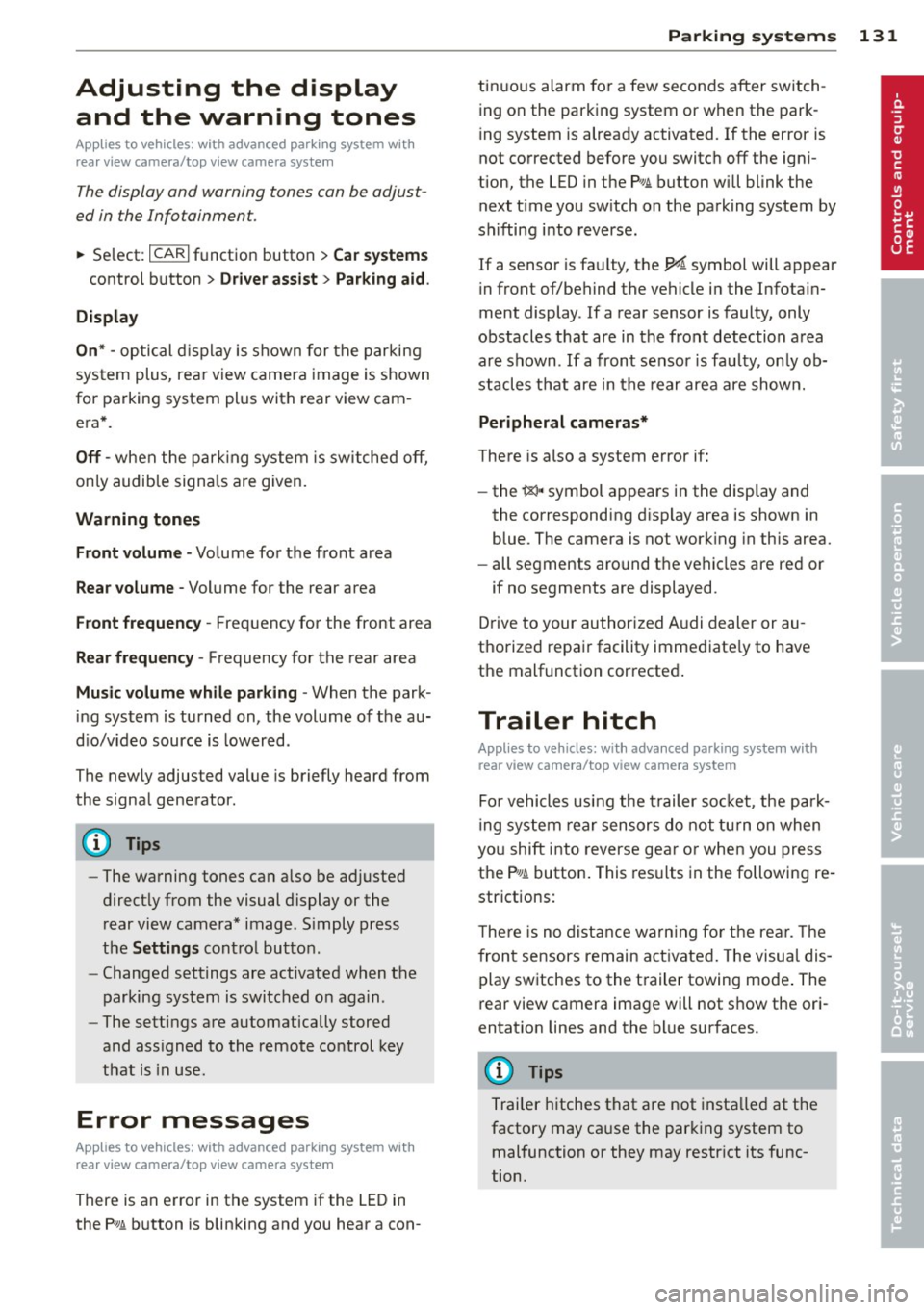
Adjusting the display and the warning tones
App lies to vehicles: with advanced park ing system wit h
rea r view camera/top v iew camera syste m
The display and warning tones can be adjust
ed in the Infotainment.
~ Se lect: ICARI f u nct io n button > Car systems
control button > Driver assist > Parking aid .
Display
On * -
opti cal d isplay is shown for the parking
sys tem plus, rea r view came ra image is shown
for parking system plus with rear view cam
e ra *.
Off -when t he par king system is sw itched off,
on ly audib le sign als are given.
Warning tones
Front volume -
Volume for the fro nt area
Rear volume -Volume for the rear area
Front frequency -Frequency for the front area
Rear frequency -Frequency for the rear area
Music volume while parking -When the park
in g system is turned on, the vol ume of t he au
d io/v ideo source is lower ed.
The new ly adjusted value is briefly heard from
the signa l generator.
@ Tips
- The warning tones ca n also be adjusted
direct ly from the visual display or the
rear view camera* image. S imply press
the
Settings cont ro l but to n.
- Changed settings are activated when the
parking system is switched on aga in.
- The settings are automatically stored
and ass igned to the remote control key
that is in use .
Error messages
Applies to vehicles: with a dvanced park ing system wit h
r ea r view camera/top v iew camera syste m
There is an error in t he system if the LED in
the
?# A button is blinking and you hear a con-
Parking systems 131
tin uous alarm fo r a few seconds after switch
ing on the par king system or when the park
ing system is already activated. If the error is
not corrected before you switc h off the ign i
tion, the LED in the
P,1 1.A button will blink the
next t ime you sw itch on the parking system by
shifting i nto reverse .
If a sensor is fa ulty, the!¾ symbol will appear
in front of/behind the vehicle in the Infota in
ment display . If a rear sensor is faulty, only
obstacles that are in the front detec tion a rea
a re shown . If a front sensor is fau lty, on ly ob
s tacles t hat are in the rear area are shown.
Peripheral cameras*
There is also a system error if:
- the
'(gl ,, symbol appears i n the display and
the corresponding d isp lay area is shown in
blue. The camera is not work ing in this area.
- all segments aro und the vehicles are red or
if no segments are displayed.
D rive to your authorized A udi dealer or au
thorized repair facility immed iate ly to have
the malfunction correcte d.
Trailer hitch
Applies to vehicles: wi th adva nced parking syste m with
rear view ca mera/top view ca mera system
Fo r vehicles using the trailer so cket, the pa rk
i ng sys tem rear sensors do not tu rn on when
you shift i nto reverse gea r or when you press
the
P,#~ button . This res ults in the following re
strictions:
T he re is no dist ance warn ing fo r th e rea r. T he
fron t sensors remain act ivated. The visua l dis
play switches to the t railer towing mode . The
rear view camera image will not show the or i
entat ion lines and the bl ue surfaces.
(D Tips
Trai ler h itches that are not insta lled at the
factory may ca use the park ing system to
malfunction or they may restr ict its func
tion.
Page 142 of 318
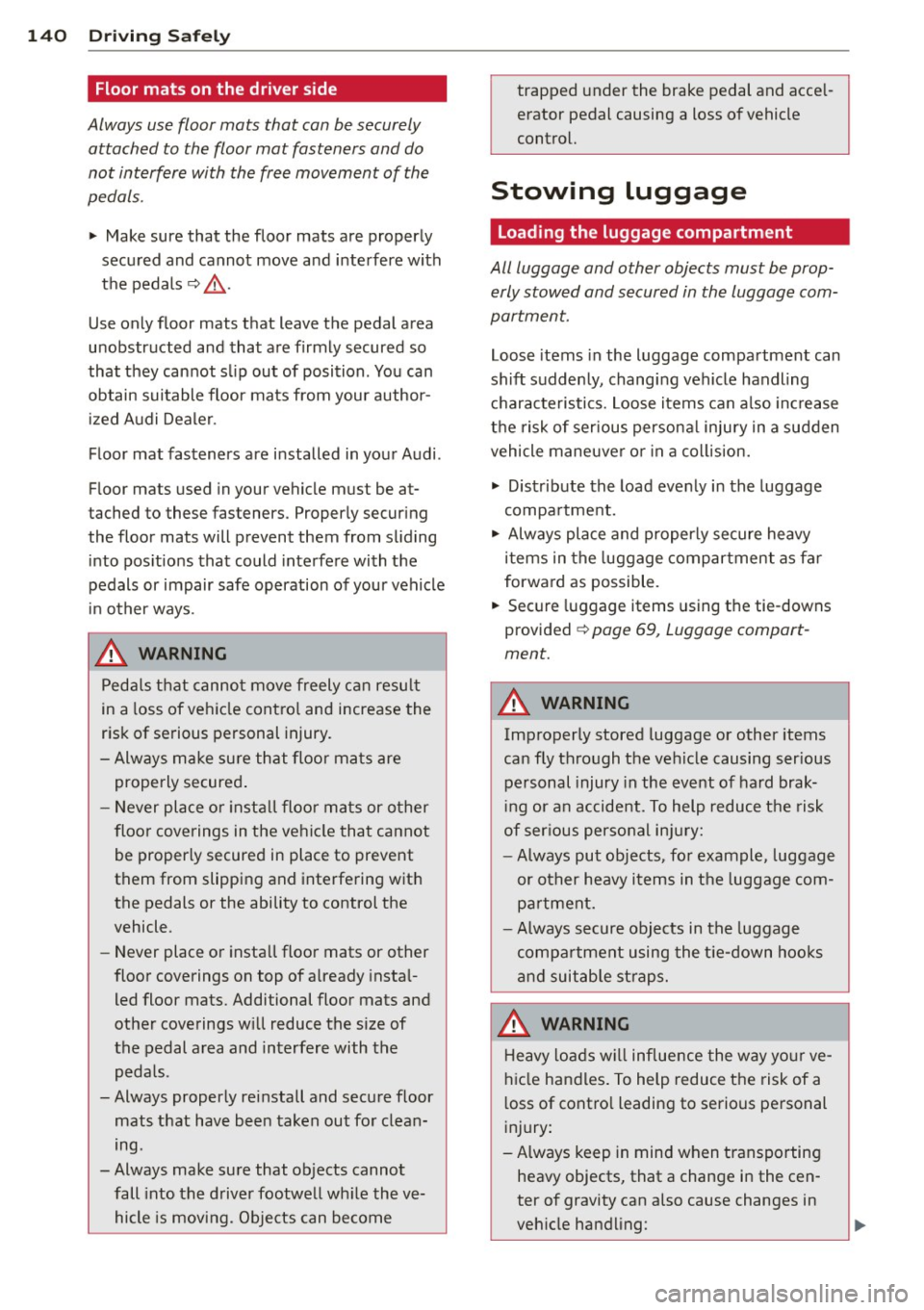
140 Driving Safely
Floor mats on the driver side
Always use floor mats that can be securely attached to the floor mat fasteners and do
not interfere with the free movement of the
pedals.
~ Make sure that the floor mats are properly
secured and cannot move and interfere with
the pedals ~,&. .
Use only floor mats that leave the pedal area
unobstructed and that are firmly secured so
that they cannot slip out of position . You can
obtain suitable floor mats from your author
ized Audi Dealer.
Floor mat fasteners are installed in your Audi.
Floor mats used in your vehicle must be at
tached to these fasteners. Properly securing
the floor mats will prevent them from sliding into positions that could interfere with the
pedals or impair safe operation of your vehicle
in other ways .
_& WARNING
Pedals that cannot move freely can result
in a loss of vehicle control and increase the
risk of serious personal injury.
- Always make sure that floor mats are
properly secured.
- Never place or install floor mats or other
floor coverings in the vehicle that cannot
be properly secured in place to prevent
them from slipping and interfering with
the pedals or the ability to control the
vehicle.
- Never place or install floor mats or other
floor coverings on top of already instal
led floor mats. Additional floor mats and
other coverings will reduce the size of
the pedal area and interfere with the
pedals .
- Always properly reinstall and secure floor
mats that have been taken out for clean
ing .
-Always make sure that objects cannot fall into the driverfootwell while the ve
hicle is moving. Objects can become trapped
under the brake pedal and accel
erator pedal causing a loss of vehicle
control.
Stowing luggage
Loading the luggage compartment
All luggage and other objects must be prop· erly stowed and secured in the luggage com·
partment.
Loose items in the luggage compartment can
shift suddenly, changing vehicle handling
characteristics. Loose items can also increase
the risk of serious personal injury in a sudden
vehicle maneuver or in a collision.
~ Distribute the load evenly in the luggage
compartment.
~ Always place and properly secure heavy
items in the luggage compartment as far
forward as possible.
~ Secure luggage items using the tie-downs
provided
~ page 69, Luggage comport·
ment.
A WARNING ,_
Improperly stored luggage or other items
can fly through the vehicle causing serious
personal injury in the event of hard brak
ing or an accident. To help reduce the risk
of serious personal injury:
- Always put objects, for example, luggage
or other heavy items in the luggage com
partment.
- Always secure objects in the luggage
compartment using the tie-down hooks
and suitable straps.
A WARNING
Heavy loads will influence the way your ve
hicle handles. To help reduce the risk of a
loss of control leading to serious personal
injury:
- Always keep in mind when transporting
heavy objects, that a change in the cen
ter of gravity can also cause changes in
vehicle handling:
Page 200 of 318
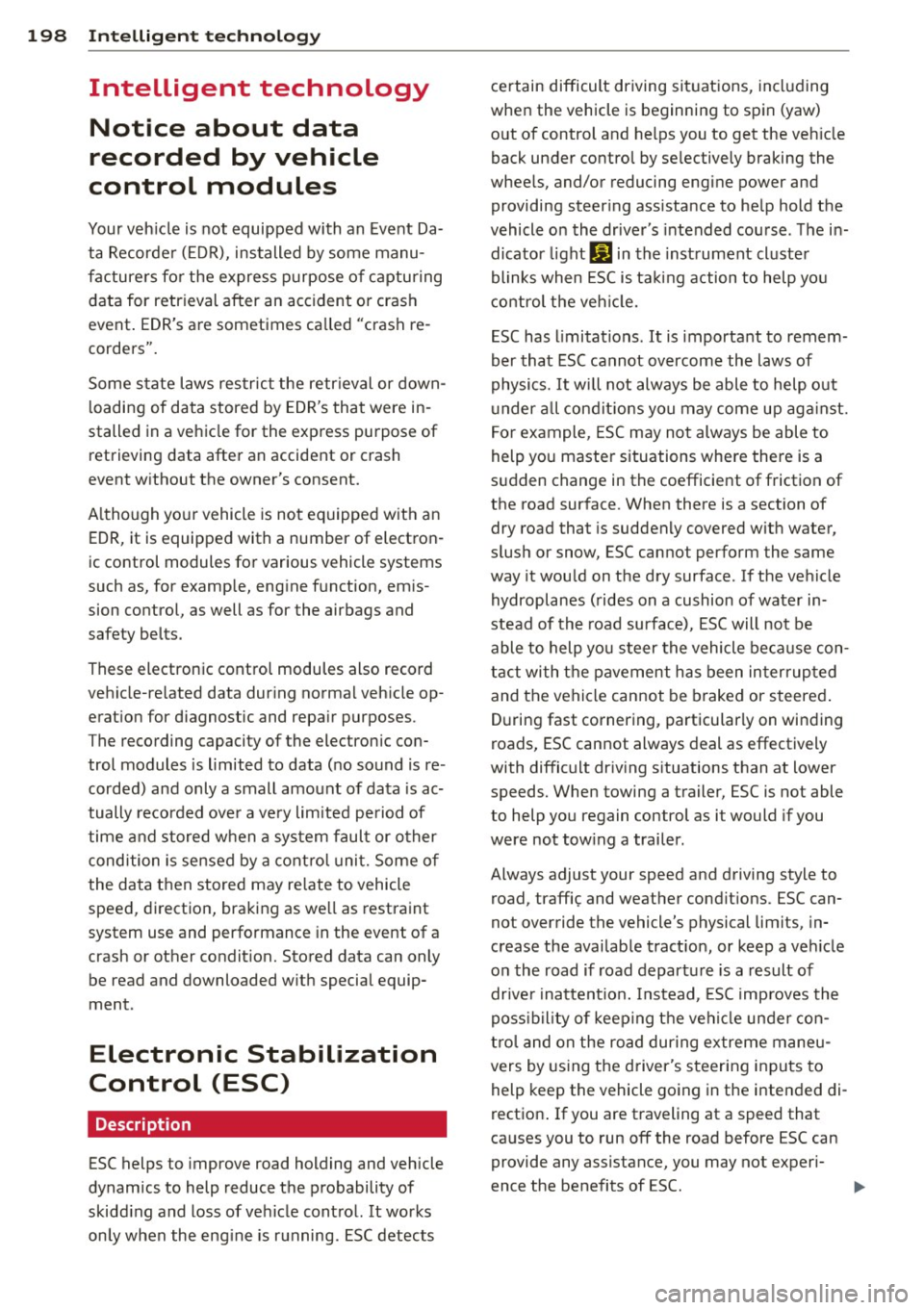
198 Intellige nt tec hno logy
Intelligent technology
Notice about data
recorded by veh ic le
control modules
Your vehicle is not equipped with an Event Da
ta Recorder (EDR), installed by some manu
facturers fo r the express purpose of capturing
data for retrieval after an accident or crash
event . EDR's are sometimes called "crash re
corders".
Some state laws restrict the retrieval or down
loading of data stored by EDR's that were in
stalled in a vehicle for the express purpose of
retrieving data after an accident or crash
event without the owner's consent.
A lthough your vehicle is not equipped with an
EDR, it is equipped with a number of electron
ic control modules for various vehicle systems
such as, for example, engine function, emis
sion control, as well as for the airbags and
safety belts.
These electronic control modules also record
vehicle-related data during normal vehicle op
eration for diagnostic and repair purposes.
The recording capacity of the electronic con
trol modules is limited to data (no sound is re
corded) and only a small amount of data is ac
tually recorded over a very limited period of
time and stored when a system fault or other
condition is sensed by a control unit. Some of
the data then stored may relate to vehicle
speed, direction, braking as well as restraint
system use and performance in the event of a
crash or other condition. Stored data can only
be read and downloaded with special equip
ment.
Electronic Stab ilization
Control (ESC)
Description
ESC helps to improve road holding and vehicle
dynamics to help reduce the probability of
skidding and loss of vehicle control. It works
only when the engine is running. ESC detects certain difficult driving situations, including
when the vehicle is beginning to spin (yaw)
out of control and helps you to get the vehicle back under control by selectively braking the
wheels, and/or reducing engine power and
providing steering assistance to help hold the
vehicle on the driver's intended course. The in
dicator light
G) in the instrument cluster
blinks when ESC is taking action to help you
control the vehicle.
ESC has limitations.
It is important to remem
ber that ESC cannot overcome the laws of
physics. It will not always be able to help out
under a ll cond itions you may come up against.
For example, ESC may not always be able to
help you master situations where there is a
sudden change in the coefficient of friction of
the road surface. When there is a section of
dry road that is suddenly covered with water,
slush or snow, ESC cannot perform the same
way it would on the dry surface . If the vehicle
hydroplanes (rides on a cushion of water in
stead of the road surface), ESC will not be
able to help you steer the vehicle because con
tact with the pavement has been interrupted
and the vehicle cannot be braked or steered.
During fast cornering, particularly on winding
roads, ESC cannot always deal as effectively
with difficult driving situations than at lower
speeds. When towing a trailer, ESC is not able
to help you regain control as it would if you
were not towing a trailer.
Always adjust your speed and driving style to road, traffic; and weather conditions. ESC can
not override the vehicle's physical limits, in
crease the available traction, or keep a vehicle
on the road if road departure is a result of
driver inattent ion. Instead, ESC improves the
possibility of keeping the vehicle under con
trol and on the road during extreme maneu
vers by using the driver's steering inputs to
help keep the vehicle going in the intended di
rection . If you are traveling at a speed that
causes you to run off the road before ESC can
provide any assistance, you may not experi
ence the benefits of ESC.
Page 204 of 318
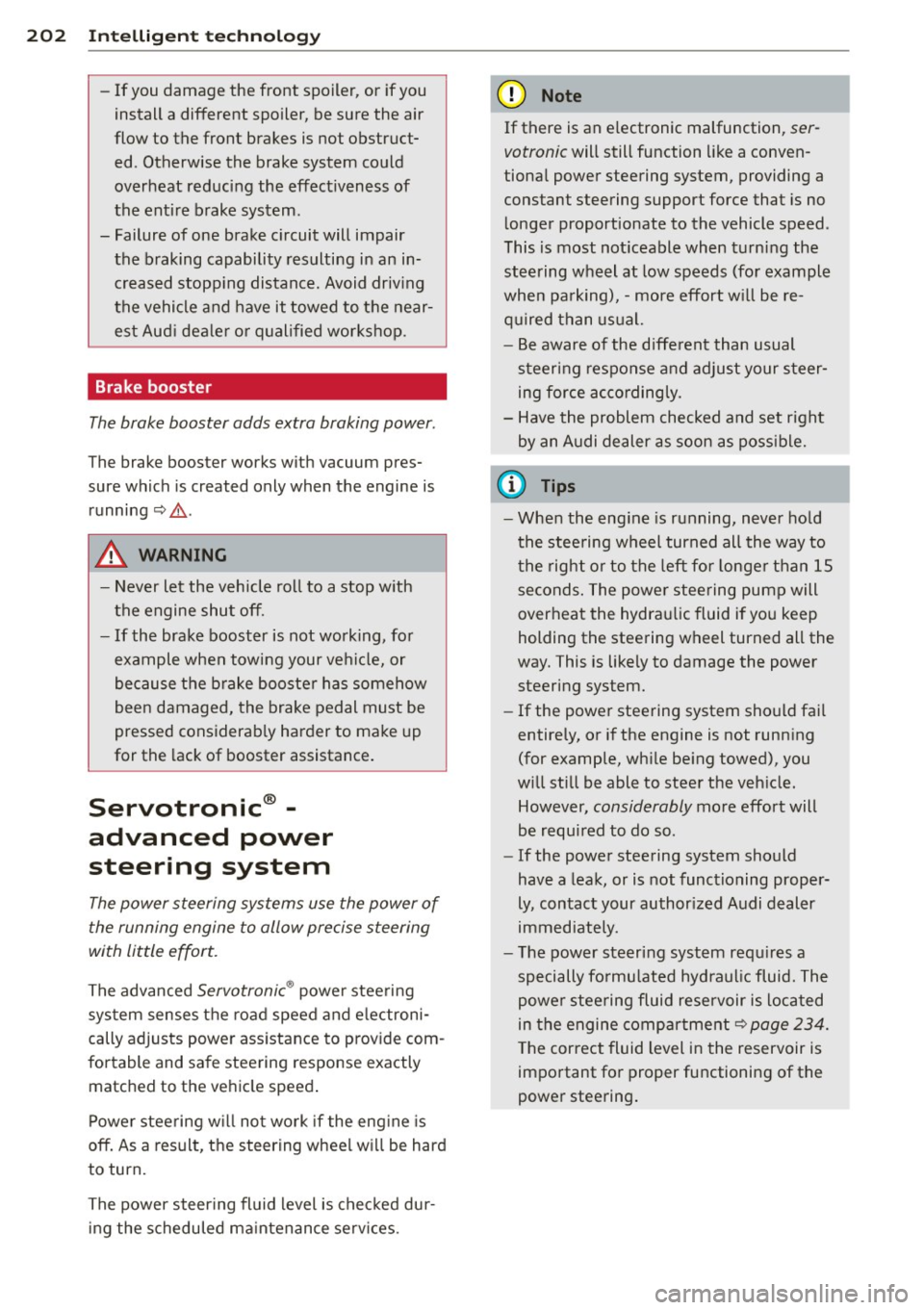
202 Intellig ent technol ogy
- If you damage the fro nt spoiler, or if you
install a different spoiler, be sure the air
flow to the front brakes is not obstruct ed . Otherwise the brake system could
overheat reducing the effectiveness of
the ent ire brake system .
- Failure of one brake c ircuit will impair
the braking capability resulting in an in creased stopp ing distance. Avoid driv ing
the vehicle and have it towed to the near est Aud i dea ler or qualified workshop .
Brake booster
The brake booster adds extra braking power .
The brake booster works with vacuum pres
sure which is created only when the engine is
running ¢& .
& WARNING
-Never let the vehicle ro ll to a stop w ith
the engine shut off.
- If the brake booster is not work ing, for
example when towing your vehicle, or
because the b rake booste r has somehow
been damaged, the brake pedal must be
pressed considerab ly harder to make up
for the lack of booster assistance .
Servotronic® -
advanced power
steering system
The power steering systems use the power of
the running engine to allow precise steering
with little effort.
The advanced Servotronic ® power steering
system senses the road speed and e lectroni
cally adjusts powe r ass istance to p rov ide com
fortable and sa fe stee ring response exactly
matc hed to the ve hicle speed .
Power steering w il l not work if the eng ine is
off . As a result, the steering whee l w ill be hard
to turn.
The power steering fluid level is chec ked dur
ing the scheduled ma intenance serv ices.
(D Note
If there is an e lectronic malfunction, ser
votronic
will still function like a conven
tiona l power steering system, providing a
constant steering support force that is no
l onger proportionate to the vehicle speed.
This is most not iceable when t urning the
steering wheel at low speeds (for example
when pa rking), - more effort w ill be re
q uired than us ual.
- Be aware of the diffe rent than usual
steering response and adjust your steer
ing force acco rding ly.
- Have the problem checked and set right
by an A udi dealer as soon as poss ible.
(D Tips
- When the eng ine is running, never ho ld
the stee ring wheel turned all the way to
the rig ht or to the left fo r longer than 15
seconds. The powe r stee ring pump will
overheat the hydraulic fluid i f yo u keep
holding the stee ring wheel turned all the
way. This is likely to damage the power steering system.
- If the powe r steering system sho uld fai l
entire ly, or if the engine is not runn ing
(for example, wh ile be ing towed), you
w ill still be able to stee r the veh icle.
However,
considerably more effort will
be requi red to do so.
- If the power steering system should
have a leak, or is not functioning proper
ly, contact your author ized Audi dealer
immed iately.
- The power steer ing system req uires a
specially fo rmu lated hyd raulic fluid. The
powe r stee ring fluid reservoir is located
in the engine comp art ment¢
page 234.
T he cor rect fluid level in the reservoir is
impo rtant fo r proper functioning of the
powe r stee ring .
Page 213 of 318
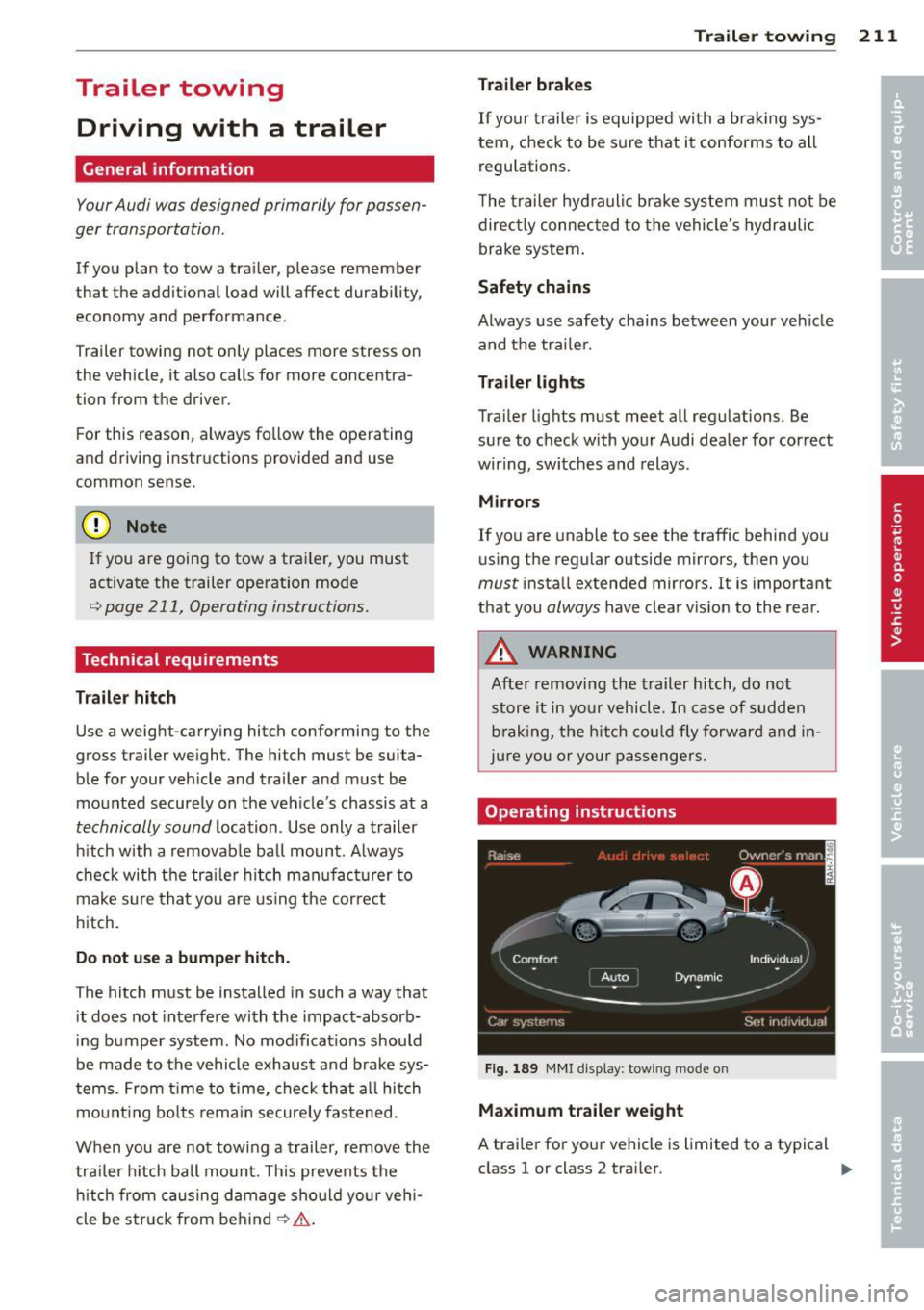
Trailer towing Driving with a trailer
General information
Your Audi was designed primarily for passen
ger transportation .
If you plan to tow a trai ler, p lease remember
that the addit ional load will affect durab ility,
economy and performance .
Trailer towing not on ly places more stress on
the vehicle, it also calls for more concentra
tion from the driver.
F or this reason, a lways fo llow the operating
and d riving instr uctions provided and use
common sense.
(D Note
If you are going to tow a trai ler, you must
activate the trailer operat ion mode
~ page 211, Operating instructions.
Technical requirements
Trailer hitch
Use a weight-carrying hitc h co nforming to the
gross trailer we ight. The hitch must be suita
b le for your veh icle and trailer and must be
mounted secure ly on the veh icle's chassis at a
technically sound location . Use only a trailer
hi tch wit h a removab le ball moun t. A lways
check with t he trail er hitch ma nufactur er to
make sure tha t you are using the corre ct
hi tch.
Do not use a bumper hitch.
The hitc h must be installed in such a way that
i t does not interfere with the impac t-absorb
i ng bumpe r sys tem. No mod ifica tio ns should
be made to the vehicle exh aust a nd brake sys
tems . From time to time, check that a ll hitch
mo unt ing bolts remain securely fastened.
W hen you are not towing a trail er, remove the
traile r hitch ball mount. Th is prevents the
hi tch from causing damage sho uld your ve hi
cle be str uck from behind ¢& .
Trailer towin g 211
Trailer brakes
If your trailer is equippe d wi th a br akin g sys
tem, check to be s ure that i t conforms to all
r egulations .
T he trailer hy draul ic brak e sys tem mus t not be
direc tly connec ted to the vehi cle' s h ydraulic
brake system .
Safety chains
Always use safety chains between your veh icle
and the tra ile r.
Trailer lights
Trai ler lights must meet all regu lations. Be
su re to check with your Audi dealer for cor rect
wir ing, swi tches and relays .
Mirrors
If you are unable to see the traffic behind you
us ing the reg ular o utside mirrors, then you
must insta ll extended mirrors. It is imp ortant
that you
always have clea r v is ion to the rear.
A WARNING ...__ -
Afte r removing the trailer hitch, do not
stor e it i n yo ur v ehicl e. In cas e o f sudden
b ra king, the hitch co uld fly forwar d and in
ju re you or your p ass en ger s.
Operating instructions
Fi g. 189 MM I dis pl ay: tow ing mode on
Ma ximum trailer weight
A trai ler fo r you r vehicle is limited to a typical
class 1 or class 2 tra iler.
ll>
Page 214 of 318
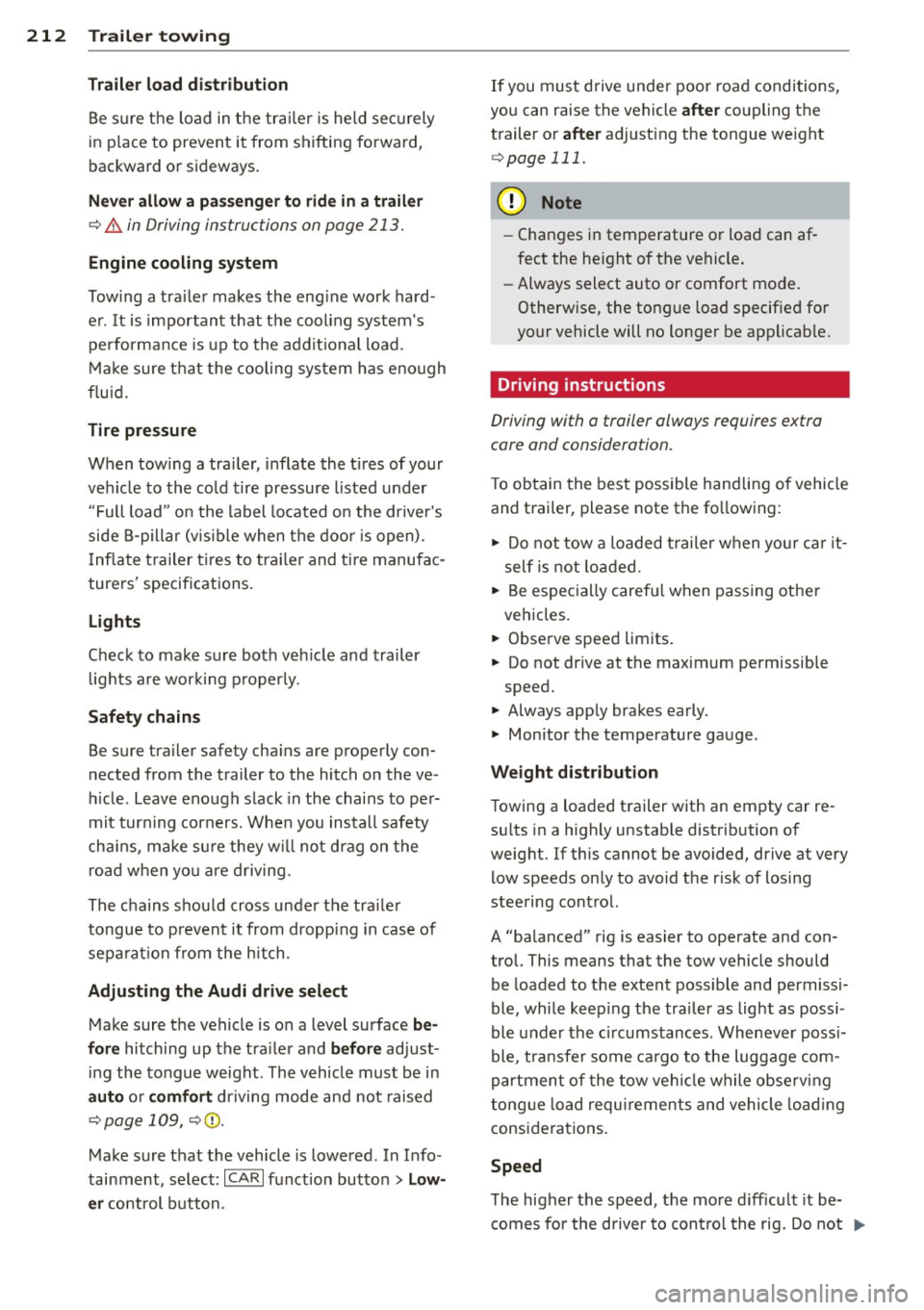
212 Trailertowing
Trail er load dis tr ibut ion
Be sure the load in the trai ler is held securely
in place to prevent it from shifting forward,
backward or sideways.
N eve r all ow a p assenger to rid e in a trailer
~.&. in Driving instructions on page 213.
Engine cooling sy stem
Towing a tra iler makes the eng ine work hard
er . It is important that the cooling system's
performance is up to the addit ional load .
Make sure that the cooling system has eno ugh
flu id.
Tir e pressure
When tow ing a tra iler, inflate the t ires of your
vehicle to the co ld tire pressure listed under
" Full load " on the label loca ted o n the dr iver's
side B-pillar (v is ible when the door is open).
I nflate trailer tires to tra iler and tire manufac
turers' specifications.
Lights
Check to make sure both veh icle and trailer
l ights are wor king p roperly.
Safe ty chain s
Be sure tra iler safety cha ins are properly con
nected from the trailer to the hitch on the ve
h icle . Leave enough slack in the chains to per
mit turning corners . When you install safety
cha ins, make su re they w ill not drag on the
road when yo u are driving.
The chains shou ld cross under the tra iler
tongue to prevent it from dropping in case of
separat ion from the hitch .
Adjusting the Audi drive select
Make sure the vehicle is on a level surface be
for e
hitching up the tra iler and b efor e adjust
ing the tongue weight . The vehicle must be i n
auto or comfort driving mode and not raised
~ page 109, ~CD .
Make sure that the vehicle is lowered . In Info
tainment, select:
I CARI function button > Low
e r
control button . If you must drive under poor road conditions,
you can raise the vehicle
afte r coupling the
trailer or
a fter adjust ing the tongue we ight
~ page 111.
(D Note
-Changes in temperature or load can af
fect the height of the vehicle .
- Always select auto or comfort mode .
Otherw ise, the tongue load specified for
your vehicle will no longer be applicable.
Driving instructions
Driving with a trailer always requires extra
core and consideration.
T o obtain the best possible hand ling of vehicle
and trailer, please note the fo llowing:
.. Do not tow a loaded t railer when you r ca r it
self is not loaded .
.. Be especially carefu l when passing other
vehicles.
.. Observe speed limits.
.. Do not drive at the maximum permissible
speed .
.. Always apply brakes early .
.. Monitor the temperature gauge .
Weight di stribut ion
T owing a loaded trailer with an empty car re
su lts in a highly unstable d istribution of
weight. If this cannot be avoided, drive at very
l ow speeds only to avoid the risk of losing
steering control.
A "balanced" rig is easier to operate and con
trol. This means that the tow vehicle should
be loaded to the extent possible and permissi
ble , while keep ing the trailer as light as possi
ble under the ci rcumstances. Whenever poss i
ble , transfer some ca rgo to the luggage com
partment of the tow vehicle while obse rv ing
tong ue load requi rements and vehicle load ing
considerations .
Speed
The higher the speed, the more d ifficu lt it be
comes fo r the driver to cont rol the rig. Do not
1111>
Page 215 of 318

drive at the maximum permissible speed. Re
duce your speed even more if load, weather or
wind condit ions are unfavorable -part icularly
when going downhill.
Reduce vehicle speed
immediatel y if the trail
er shows the slightest sign of swaying .
Do not
try to stop the swaying by accelerating.
Observe speed limits . In some areas, speeds
for vehicles towing trailers are lower than for
regular vehicles .
A lways app ly brakes early. When driving
downhill, shift into a lower gear to use the en
gine braking effect to slow the vehicle . Use of
the brakes a lone can cause them to overheat
and fail.
Coolant temperature
The coolant temperature gauge c:> page 10
must be observed carefully. The coo lant tem
perature can increase if you drive on long in
clines in a low gear at high engine speeds. Re
duce your speed immed iate ly if the L EDs in
the top part of the display turn on.
F or more information about indicator lights,
refer to. ~
page 16.
A WARNING
Anyone not properly restrained in a mov
ing vehicle is at a much greater risk in an
accident . Never let anyone r ide in your car
who is not properly wear ing the restra ints
provided by Aud i.
Trailer towing tips
Important to know
Your veh icle hand les different ly when tow ing
-
a trailer because of the addit ional weight and
d ifferent weight distribution . Safety, perform
ance and economy will greatly depend on how
carefully you load your trailer and operate
your ng .
Before you actually tow your trailer, practice
turning, stopping and backing up in an area
away from traffic. Keep practicing until you
Trailer towing 213
have become completely familiar with the way
your vehicle-trai ler combination behaves and
responds.
Backing up is difficult and requires practice .
Backing up with a t railer generally requires
steering action opposite to that when backing
up your vehicle without a tra iler.
Maintain a greater distance between your ve
hicle and the one in front of you . You wi ll need
more room to stop. To compensate for the
trailer, you w ill need a larger than normal
turning radius.
When passing, remembe r that you cannot ac
ce lerate as fast as you norma lly would be
cause of the added load. Make sure you have
enough room to pass. After passing, allow plenty of room for your trailer before chang
ing lanes again.
Avoid jerky starts, sharp turns or rapid lane changes.
(D Tips
- Do not tow a trailer during the break-in
period of your vehicle.
- If you tow a trailer, your Audi may re
quire more frequent maintenance due to
the extra load
c:> page 296.
Parking on a slope
Do not park on a slope with a trailer. If it can
not be avoided, do so only a~er doing the fol
lowing:
When parking:
.,. App ly the foot brake.
.,. Have someone p lace chocks under both the
vehicle and the trailer wheels .
.,. With chocks in place, slowly release the
brakes until the wheel chocks absorb the
load.
.,. Turn the wheels towards the curb .
.,. Apply the parking brake .
.,. Select the P selector lever posit ion .
When restarting after parking:
.,. Apply the foot brake.
•
•